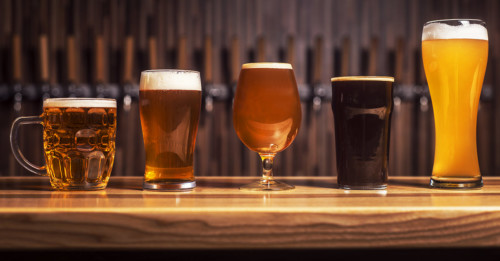You’d think it would be as simple as pointing to a pint of beer and saying “brownish.” But the color of beer, just like the taste and body, has a slightly more complicated explanation.
Because beer is made with grain-derived starches, beer colors usually land somewhere on the gold to red to brown spectrum (with variations of opacity and haziness depending on the style of the beer). We used to measure this spectrum in what were called “degrees Lovibond,” based on a system developed by J. W. Lovibond in the late 19th century. As a means of quality control, Lovibond had created a series of colored glass plates against which samples of beer could be measured. While the system worked for a time, it was also subjective—dependent on the visual interpretations of the human eye (which, under the influence of another kind of beer goggles, has historically proven…faulted).
In 1951, Lovibond’s glass plates were replaced with the light spectrophotometer methods of the Standard Reference Model (Europe’s version is called the European Brewing Convention, with a difference in scale). It basically measures the loss of intensity of a beam of blue light as it passes through a centimeter of beer.
Of course, it’s far less necessary for a beer drinker, even an avid beer drinker, to know the SRM of his or her favorite six pack. If you’re interested in brewing, though, it may be useful to pick up a color guide like the hand-held Davison guide (the Beer Judge Certification Program has also developed its own internal guide).
But if you’re just looking to take a deeper visual reading of your beer, it’s even simpler than that: when your beer arrives, drink it in with your eyes first. It may be served in a bottle or can, but the best way to get the fullest experience of your beer is with a glass: not only will the increased exposure to oxygen nudge some of the aromatics around, but you’ll actually get to see the color of the beer (we like brown and green glass as much as the next guy, but it’s not quite visually enticing).
A beer’s color can absolutely give you some hints about how it’ll taste. Chances are a beer is dark because it contains some roasted malts, so you can expect chocolate, coffee, and/or darker notes. A medium-gold beer made with wheat or barley might have some bready flavors, while a reddish beer is likely also malt-driven, with some notes of rounding fruit or nuttiness. And a light-colored beer will generally have brighter characteristics—acidity, citrus, crispness, tropical fruit notes, pepperiness, etc.
The rules aren’t hard and fast, especially as craft beer keeps diversifying styles, so keep an open mind. And of course the best way to get to know how your palate interprets what your eye sees? Look, then taste.
